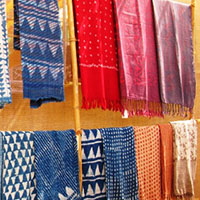 To promote handloom products, Rajasthan government will rope in international designer Bibi Russel for enhancement of value addition to fabric as weaver there continue to struggle in the absence of a direct marketing access, handloom experts feels.
To promote handloom products, Rajasthan government will rope in international designer Bibi Russel for enhancement of value addition to fabric as weaver there continue to struggle in the absence of a direct marketing access, handloom experts feels.
They have to go doorbelling to sell the handmade saris braving the challenge posed by mushrooming powerloom fakes passed into the market as a cheap option. The price of a handloom sari begins from Rs 2,500 a piece whereas its powerloom copy is available for Rs 250 to Rs 1,500, experts said.
According to most weavers, they need policy protection and better marketing opportunities to promote the product internationally and augment their income as well. Weaver Rehana Bano admits that the Russel-like efforts give the product a dash of innovative designing to hand- made saris, but said what is needed is direct marketing access to weavers.
Russel’s fashion show has helped augment weavers’ earnings too. But, still that is not enough to make them self reliant industrial units, who take pride in their work and feel rewarded by selling their product at good prices. What we need is marketing outlets.
President of the Kota Doria Hadauti Foundation (KDHF) Nasruddin Ansari said that the augmentation in weavers’ wages is a positive sign. But, the price of a sari depends on the designing work it has — that is also a factor, besides a need for a marketing push in the face of challenges thrown down by the fakes.
According to former president of the KDHF Abdul Waheed Ansari, the good thing is that the number of looms has increased from 1,500 to 2,500 over the years, engaging around 3000 weavers, who contribute to “the total business of around Rs 85 crore” every year. He links the change to Bibi Russel effect. Russell introduced new designs in the Kota Doria which is a fabric made of cotton and silk yarn with square patterns called Khat in the local dialect.
International fashion designer Bibi Russel, during her visit to Kota last December, said that she saw a possibility of improved marketing and access of Kota Doria to more and more buyers. She had also asserted the need for a value addition to the fabric by diversifying into manufacturing lady suits, stoles, men apparels and others besides saris.















